Housing land audits: research project
Assessment of housing land audits (HLAs) for consistency and compliance, their potential for standardisation and their role in development plan delivery.
4 Survey and Consultations
Introduction
4.1 The research into Housing Land Audits included an online questionnaire survey of Scottish local planning authorities. This was supplemented by individual consultations and a panel review of emerging research findings in March 2018. The survey is reported first below, followed by a summary of the consultations.
Planning Authority Survey
4.2 The online survey was issued to the 32 Scottish local development planning authorities in late February 2018 and held open until late March 2018. The survey secured a 100% response rate.
4.3 The analysis below provides the combined responses to each survey question. Where free text or supplementary comment was requested, a summary review of those written responses is also provided. As an indication of the depth of interest in this topic among local planning authorities, the exercise attracted not only a full response, but also more than 12,000 words of written comment.
4.4 Question 1 asked respondents to indicate which planning authority they were responding on behalf of. As noted above a full response was secured. The two National Park local planning authorities were not surveyed, as they do not produce separate HLAs; for example, Cairngorm relies on HLAs produced by Perth & Kinross, Moray, Highland and Aberdeenshire local planning authorities.
4.5 Question 2. Please select your job title.
A significant majority of respondents (78% - see chart) are planners, senior planners or planning managers. Three respondents are research officers rather than planners. The response implies that the production of HLAs may require qualification, knowledge and experience rather than simply being straightforward data-based monitoring reports.
Respondents’ Job Titles
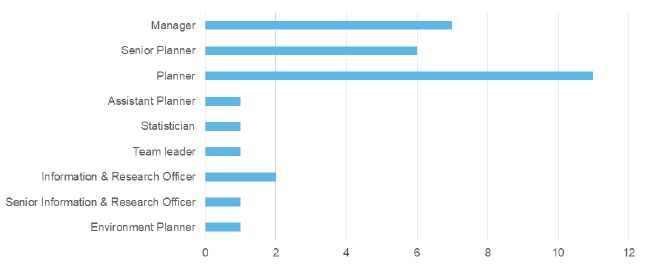
4.6 Question 3 asked respondents to confirm all sources for housing completions data in their HLAs.
Sources for Housing Completions Data
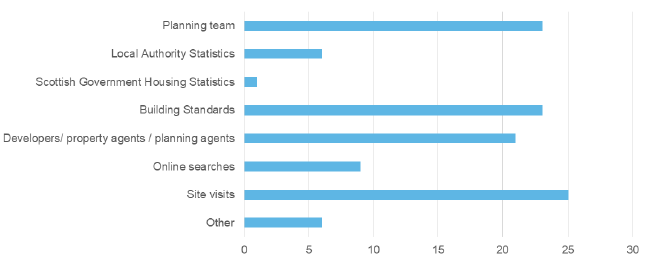
A significant majority source housing completions data from four principal sources: their planning team; their Building Standards colleagues; developers, property agents and planning agents; and site visits.
A minority selected ‘local authority statistics’, which may also refer to Planning or Building Standards departments. Single responses were made for: Scottish Government Housing Statistics, Strategic Housing Team, Strategic Housing Investment Plan, Affordable Housing Programme, completion certificates and site managers.
These responses indicate that there is no single source for data on housing completions in HLAs. The average authority is using between 3 and 4 different sources. This implies that cross-checking, and possibly reconciliation of different or misaligned housing completions data, is being undertaken during the audit process.
4.7 Question 4 asked what methods are used to transfer and validate housing completions data.
Methods Used to Transfer and Validate Housing Completions Data

All local planning authorities handle and check housing completions data electronically. Paper sources and consultations are each used by approximately one-third[19] of respondents.
4.8 Question 5 sought the barriers to collating housing completions data.
Barriers to Collating Housing Completions Data
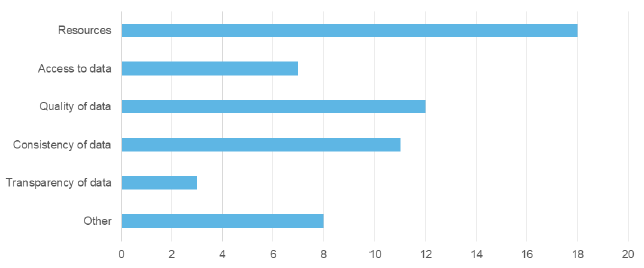
A small majority of respondents cited resources as a barrier. Other responses were made by minorities related to quality, consistency and access to completions data. Three respondents reported delays in receiving information on completions and one inconsistency across systems. Two respondents stated that there are no barriers to collating housing completions data.
4.9 Question 6 asked for methods and data sources used to forecast future housing completions.
Methods and Data Sources Used to Forecast Future Housing Completions
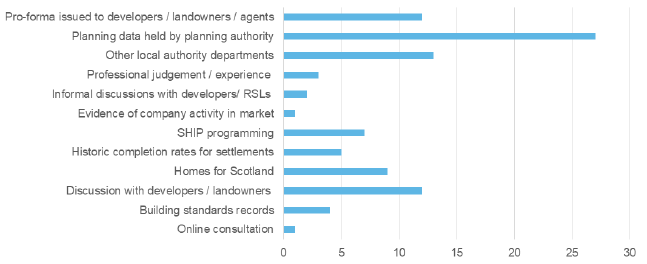
The large majority of respondents use planning authority data to project future house completions. Just over one-third also issue pro formas to developers / landowners / agents to ask for their anticipated future completions.
Projecting house completions involves a wide range of sources. These include: past completion rates (market and affordable), buildings under construction, developer and landowner projections, site visits, planning permissions, planning application supporting statements, Council housing services (and other asset teams if relevant to land supply), SHIP programming for RSL sites, Homes for Scotland advice, marketability assessments, the state of housing market and construction sector, professional judgement and planners’ local knowledge, online searches, Key Agencies, and data from the previous HLA trawl which fell after the cut-off date. Some authorities have ‘rule-of-thumb’ guidance for anticipated completions by site and developer type and the stage of the site in the planning process (eg. no completions in first two years of planning permission).
4.10 Question 7 asked whether those preparing HLAs request further evidence from developers / landowners / agents to justify projected house completions.
The responses to Question 6 indicated that almost half of authorities formally sought external information on projected completions (although the free text indicates that others may also consult on this less formally). The responses to Question 7 indicates that around one-third of authorities then seek further evidence from those parties. That information tends to concern site status, effectiveness, build programme, sales performance and marketing activity, developer interest (if applicable), reasons for any delays, and any build rates proffered which do not look realistic or conflict with other information. Some authorities report using Homes for Scotland’s guidance on build rates, which may include confirmation of programming with them.
The broad implication from Questions 6 and 7 is that most authorities project future housing completions from their own sources and methods, partly informed by the projections of site promoters/developers. Cross-comparing this information with responses at Question 20 below indicates that most authorities seek that external comment on programming at a later stage around a draft HLA, rather than as a data input.
4.11 Question 8 asked how authorities treat sites where forecast completions did not happen. Generally the authorities responded that sites are reassessed each year, in conjunction with planning colleagues, developers and other consenting authorities where appropriate, to determine the reasons for any non-completion. That information is also retained by some authorities for the next LDP review.
This reassessment may lead to the programming being moved back by a year, or otherwise adjusted depending upon the specific reasons. For example, a site infrastructure constraint or an event such as developer administration can lead to a delay in developing. ‘Non-contributing HLA sites’ were noted as being those with no forecast completions, while more challenged sites can be reclassified as non-effective[20]. If a site has not started after 3 years, then the planning permission expires and it is ignored for programming purposes. The decay of programming over time was highlighted, with current market conditions reportedly making short-term projections difficult and “a significant degree of uncertainty” when programming completions beyond 2-3 years into the future.
In smaller and rural markets, projecting completions by site can be inaccurate and projecting total activity in a market area is found to be more useful.
One authority reports that their approach to projecting / programming now, states what would need to happen to bring forward or increase delivery of house completions, including any potential interventions or planning support. This is done on a site-by-site basis and is agreed with Homes for Scotland.
4.12 Question 9 asked whether any sites included in HLAs are not agreed with developers / landowners / agents.
Approximately 60% of authorities have HLA sites, which are not agreed with the promoter/ developer. Overall, the rate of dispute appears to be low[21]. Additional comments in response to this question were also made by authorities who currently do not have any non-agreed sites.
Programming is typically discussed and agreed with Homes for Scotland (a membership organisation) rather than any individual developers. Some also consult with a dominant RSL in their area. Some authorities host an event at which promoters / developers may challenge each other’s site programming.
Authorities seek firstly to resolve any disputes. Any remaining non-agreed sites are identified and published in the HLA as ‘disputed’. The reason for the dispute can be used to inform the next HLA. One authority reports that the rate of dispute for HLA sites increases at the critical stage of LDP preparation, and when there are planning appeals testing the housing land supply.
A tendency was reported for landowners and agents – rather than developers - to “programme positively”, without necessarily having any means to deliver that development. In those circumstances, the authority takes a “realistic view” which may not align with the promoter’s aspirations. Local builders are also reported as sometimes over-estimating their capacity to deliver new houses.
4.13 Question 10 asked respondents to summarise the method adopted in calculating and presenting their effective 5-year housing land supply[22].
Most respondents describe the process of dividing the 5-year housing land supply by the 5-year housing supply target, then multiplying the result by 5 (all expressed in housing units). A figure of less than 5 indicates a numerical shortfall against the target, a figure above 5 a surplus. Some reference this calculation to Planning Performance Framework Guidance or the withdrawn 2016 Draft Planning Delivery Advice: Housing and Infrastructure (see Section 2). One notes that the calculation is the 7-year HLS divided by the HST multiplied by 5. Another indicates that they use a 12-year strategic development planning horizon to reach the 5-year effective housing land supply figure.
A minority of respondents described in response to Question 10, that the housing land supply is set out in the LDP. Completions are then deducted at each HLA. This does not obviously incorporate a test against target to identify shortfall or surplus, although it is difficult to be certain from the written responses alone.
Three authorities distinguish between the effective 5-year land supply and the projected 5-year completion figure. This approach measures the housing supply land and the delivery of homes “as separate things”. The latter is programmed using the 5-year approach and the land supply presented as ‘remaining’ at the current rate of delivery[23]. The capacity of effective housing land is thus presented in two ways: against the housing land target and the anticipated programme against a delivery target.
4.14 Question 11 asked whether newly approved Housing Needs and Demand Assessments (HNDAs) should immediately inform annual HLA demand requirements[24].
A two-thirds majority of respondents state that newly approved HNDAs should not immediately inform HLAs. Under the current system, the requirement for housing land is developed through the planning process. That is required to translate need and demand into a policy via a Housing Supply Target (HST). Unlike the HST, the HNDA does not take account of “capacity, resource availability, deliverability or economic, social and environmental factors”. The majority respond that it would be inappropriate to use a new HNDA as a basis for informing HLA demand requirements. The HLA is simply a monitoring tool.
Taking a more nuanced view, one respondent suggested that a new HNDA should not inform the HLA, but could inform planning applications. Another suggested that new HNDAs should be given some weight, but treated with caution. One cautioned that the implications require to be considered, but HNDAs immediately informing HLAs is something to work towards.
Notably, one-third of respondents took the opposite stance. They suggest that a new HNDA would allow the planning system to be more responsive to the housing system. The most up-to-date picture allows the planning authority to consider whether the housing supply is meeting current need and demand. One respondent simply reported that any new HNDA already does inform their HLA.
4.15 Question 12 asked what role Local Housing Strategies (LHSs) and Strategic Housing Investment Plans (SHIPs) should have in informing HLAs.
The large majority of respondents report that these are used in HLAs to provide up to date information, identify sites, highlight locations of likely change, identify funding commitments (SHIPs), and support programming/ delivery forecasts across RSLs and Council housing. The LHS provides overall direction which is then progressed through the SHIP.
The terms ‘crucial’ and ‘critical’ recurred in responses to this question. However, 3 respondents indicated that the LHS and SHIP should not inform HLAs.
4.16 Question 13 asked which market sectors are differentiated within HLAs’ effective housing land supply.
Market Sectors Differentiated Within HLAs’ Effective Housing Land Supply
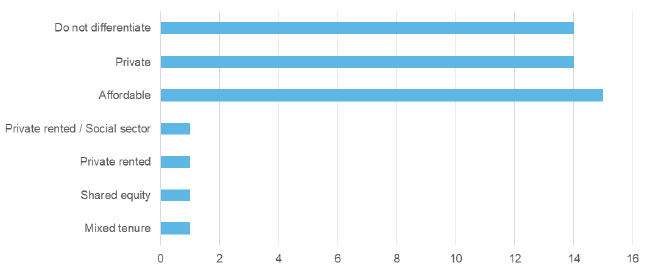
Nearly half of authorities do not differentiate between housing sectors. Most of the balance of respondents do however differentiate by tenure: private or affordable. Reasons for this split include different targets, funding and delivery.
Some authorities split out historic completions by tenure, but not the effective land supply. This is because they do not know who ultimately will deliver the development. Others do split sites using either known commitments or a standard affordable housing percentage. Some respondents further split affordable housing into Council or RSL. Some show any affordable housing delivered by a private developer as ‘private’ (whether these are RSL completions as part of a planning permission or low cost home ownership developer units).
The Clydeplan authorities in West Central Scotland split subsidised rented housing from all other of types of housing; social rent and mid-market rent are in one category while the other includes subsidised ownership, private ownership and private rent. In East Central Scotland, SESplan2 proposes separate housing land targets/ requirements for affordable and market housing tenures, which if adopted would need to flow into HLAs.
4.17 Question 14 asked how the requirement to provide a generosity allowance within the Housing Supply Target is reflected in the Housing Land Requirement.
Respondents mostly noted that the generosity allowance is either set out in the SDP or applied by a stand-alone LDP to the HST to reach the HLR. A large number of respondents noted that a 10% generosity allowance was applied by the development plan. Some though noted higher figures such as 15%, 20%, 30% (emerging plan) and 35%. One older LDP has no generosity allowance.
4.18 Question 15 invited comments on the respondent’s current practice for forecasting housing completions.
The responses are similar to Questions 6 and 7 around use of data, previous Audits, market trends, developer and housing types, settlement and infrastructure capacity, Homes for Scotland guidance and consultations, Clydeplan guidance, professional experience and “being realistic”.
In terms of additional practices, one authority uses a self-assessment developer survey in addition to their annual HLA consultation with Homes for Scotland. Another uses a detailed housing sites monitoring map, which tracks activity and helps with forecasting. Some authorities make detailed assessments of potential future windfall sites.
One respondent would welcome information on the average margin for error in forecasting completions and the sharing of best practice. Another rejected the term ‘forecast’ and indicated that they programme completions using developer information and experience. A large rural authority notes that their approach of allocating a wide choice of sites in their LDP makes it difficult to programme which sites will be developed and when. The challenge of programming for affordable housing beyond a current SHIP period was also noted.
4.19 Question 16 asked about the inter-relationship between annual HLAs and the LDP action programme.
One authority is using full programming of LDP sites and the HLA as a “monitoring regime” for site effectiveness and actions via the programme. Another reports that this integration is underway to provide a single document.
A further authority indicates that their HLA and Action Programme are now undertaken by the same team, and both inform anticipated delivery rates on housing sites.
Financial modelling and risks are analysed and reported by a small minority of respondents, including timing of actions and developer contributions, which is linked directly to programming of house building in a fixed annual reporting cycle (beginning with HLA and delivery, then Action Programme, then Council budgeting). Such integrated housing-and-delivery approaches are currently the rare exception among HLAs in Scotland.
More generally, authorities report that the HLA and Action Programme inform each other to a more or less formal extent, with the latter identifying potential issues affecting the delivery of housing sites and the required actions. Some note that the Action Programme is updated each year using the programming provided in their new HLAs, informing all parties of their responsibilities.
Authorities do report a current focus on strengthening the links and information flows between HLAs and Action Programmes, for example by considering “new style delivery programmes” by merging both as above. It was however noted that the HLA as an output will still remain separate, as it is a regular and widely acknowledged report.
4.20 Questions 17, 18 and 19 asked about consultations when preparing HLAs.
Consultations Undertaken When Preparing HLAs
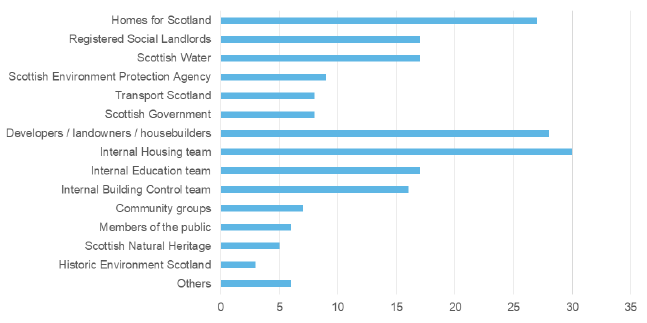
The large majority (but not all) authorities consult with their internal housing teams, Homes for Scotland and site developers/ promoters[25]. Around half of respondents consult with each of RSLs, Scottish Water, Education and Building Control. A quarter or fewer consult with each of SEPA, the Scottish Government, Transport Scotland or communities/ the public. One respondent reports a consultation with most of these and with their SDP team around the draft HLA. Another consults with the NHS.
Around half of respondents convene working groups to discuss the draft HLA.
A similar proportion (mainly the same respondents) issue an email with a link to an HLA website. The format of materials issued for consultation includes maps and draft programming. One authority reports having insufficient resources to consult on the draft HLA. Another uses their Council’s consultation portal.
Challenges reported with HLA consultation include lack of internal Council resources to comment on all sites and uncertainty over who controls some sites. The main area of challenge however is poor / late / over-optimistic / ‘ongoing dialogue’ responses from some site developers/ owners. The process of consultation through Homes for Scotland was noted as helpful and improved.
4.21 Question 20 asked local planning authorities how often they publish their HLA. All publish annually, apart from one, which has had a resource constraint but now plans to publish an annual HLA, and one rural authority, which publishes every 2 years.
4.22 Questions 21 and 22 asked about the time taken to produce HLAs. Just over half take 4-6 months. Only two local planning authorities take less than 3 months and the remainder take longer than 6 months. The implied average preparation time is 6 – 7 months.
Time Taken to Produce HLAs

As explored by the questions in this survey, an extensive process is involved in producing HLAs. Where authorities broke down the process in their responses, the typical stages take:
- data gathering 1-5 months; typically 2 months but longer if site visits made
- analysing survey data and compiling draft HLA around 1 month
- consultations 2-3 months (with outliers of 1 month and 4 months)
- finalising and reporting 1 month
One authority reporting shorter timescales advises that data gathering is ongoing rather than a specific HLA task. Similarly, another monitors completions and planning activity on a monthly basis, which keeps the annual HLA task manageable and quicker; that authority also reports that the HLA timescale is meshed with other programmes rather than separate.
4.23 Questions 23 and 24 asked about interactive HLA mapping on the local planning authority’s website.
Just under half [26] of respondents report that interactive HLA mapping is provided. One-third do not provide interactive mapping. The balance of respondents plan to introduce interactive mapping in future. The main barriers to providing this are resources, costs and insufficient technical expertise. A number of respondents noted that Geographic Information Systems (GIS) are now in place within their planning departments and this will aid interactive mapping for HLAs in future.
Provision of Interactive HLA Mapping

4.24 Question 25 asked whether respondents plan any further refinements to HLA data collation and analysis.
Planned Refinements to HLA Data Collation and Analysis
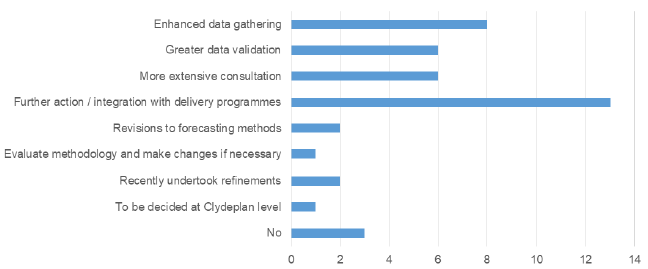
Just under half propose to better integrate HLAs with Action / Delivery Programmes. Smaller numbers have plans to enhance their data analysis or consultation processes. Some respondents pointed to work already undertaken recently to utilise GIS or to programme delivery.
4.25 Questions 26 and 27 asked about further guidance on preparing HLAs.
Requirement for Further Guidance on Preparing HLAs

Approximately two-thirds of local planning authorities would like further guidance on the preparation of HLAs. The remaining third are not seeking further guidance.
The guidance sought is firm rather than descriptive or general: a standard national process for HLAs and in particular the calculation of a 5-year effective housing land supply including across time periods and the treatment of any shortfalls identified by that calculation. The 5-year methodology in the Planning Performance Framework and the withdrawn 2016 Draft Planning Delivery Advice - Housing and Infrastructure received positive mention.
Current guidance is felt to be vague and can lead to different and conflicting methodologies. This can reportedly extend to different interpretations by independent Reporters. New guidance around the Planning Bill is sought.
Further guidance is sought on effectiveness of housing sites where marketability may be the only constraint, particularly where areas are to be regenerated. It was suggested that marketability is not as fixed as other constraints. PAN 2/2010 remains relevant, but the policy emphasis on housing and delivery has increased during the 8 years since it was published. Better guidance on marketability and programming for rural authorities is sought.
Other areas where clarity is felt to be required include: analysis and reporting by housing market and/ or local authority areas; differentiating between land supply and housing projections (this has emerged recently and may be gaining interest); and guidance on best practice in linking HLAs with Action Programmes.
Consultations
4.26 Consultations with HLA stakeholders and a research panel discussion built upon the survey by examining topics in more detail. Although often the responses (understandably) went beyond narrow HLA matters, into more general housing land issues, these issues are reported here as it provides useful context.
4.27 Those consulted to inform the research programme were: Heads of Planning Scotland; Homes for Scotland; the Improvement Service; the Royal Town Planning Institute; the Scottish Federation of Housing Associations; the Scottish Planning Consultants’ Forum; the Scottish Property Federation; and Stirling Council (for a detailed process-based Housing Land Audit).
4.28 Housing Land Audits were reportedly initiated during the late 1970s. They measured the market in order to provide a land supply, and account for windfall sites within that supply. Anecdotally, the early HLAs simply took household number forecasts, checked historic build rates and then ensured both could be met.
4.29 Consistency across HLAs is a major concern of consultees. The two major areas in Scotland – Clydeplan and SESPlan – do not produce consistent data even at the most basic level of defining housing tenures. Nor are the durations selected across HLAs consistent, other than the 5-years’ effective land supply policy requirement, nor the start, completion and reporting dates of HLAs. Completions data, rather than being historical fact, suffers from different definitions, time lags, and varying use of either housing market areas or local authority areas.
4.30 Consultees suggested that other measures such as infrastructure capacity and windfall sites are likewise not dealt with consistently across local planning authorities. This then means that Action Programmes to help deliver sites and development are not consistent.
4.31 Looking forwards, there is even greater variation in whether future completions are based upon past built-out rates, industry standard rates, adjustments for type of owner or developer, and so on. There appear to be both explicit and implicit hierarchies of site promoter and speed of delivery, possibly adjusted to reflect established and anticipated market conditions.
4.32 To combat these variances, a national standard is requested for housing types and tenures, say: flats or houses; affordable or market; and specialist eg. senior living and care homes (Use Class 8) and travellers’ accommodation. HLAs should then recognise whether housing is to be delivered by the market, affordable or other sources.
4.33 Consultees noted the growing difference between the specialist and detailed nature of HLAs, linked to delivery of sites and development, and the simpler approach taken for example, with employment land, which is grouped into marketable (immediately available or having minor constraints), or having major constraints or safeguarded for a specific use.
4.34 Many HLAs are not agreed with landowners and developers, although they may note the specific points of disagreement for clarity. Consultees thought that any areas of disagreement, including promoted sites judged to be non-effective, could be made more specific, ie. by identifying the action(s), which would make those sites capable of inclusion. If the actions remain unresolved and with foreseeable resolution over a series of defined periods, sites could be noted for potential de-allocation at the next LDP [27]. Where sites are struggling with effectiveness though, taking action to remove blockages was noted as preferable to moving to other locations with their own infrastructure needs.
4.35 The potential for subjectivity in the process leading up to HLAs was raised during consultations. Housing Needs and Demand Assessments (HNDAs) provide validated evidence using standard guidance. The process of then using scenarios to reach a Housing Supply Target (HST), then a range of generosity options to set a Housing Land Requirement (HLR), was felt by consultees to be open to subjective influence. They suggested a consistent “set of rules” around this process, due to the multiple steps and optionality at each.
4.36 That said, it was felt that the role of HLAs in monitoring performance and helping with programming, is well understood. The basic approach to HLAs is common across authorities in terms of collating, analysing then reporting against SPP requirements. From the consultations, there is also a sharing of best practice, which has been increasing recently.
4.37 Consultations typically involve engagement with Homes for Scotland, on behalf of their members. Engagement with non-member builders is less common, as is engagement with affordable housing providers (some are members of Homes for Scotland and some are very large and engaged with planning, but many are not). Consultees report that regular annual consultation speeds-up the process and leads to more rapid identification of areas of potential disagreement. Some thought that too much weight is afforded to development industry views, and that those should be restricted to checking of sites information only, not whether any policy requirement is met. One interesting planning authority example used a committee chaired by an independent expert to reach an agreed HLA audit.
4.38 There is a reported delivery misalignment where market housing can be too slow and phased to bring forward batches of affordable housing. Stand-alone affordable housing in low demand housing areas may come forward faster and more easily than that integrated with private housing in stronger market areas. This should be reflected in the programming of affordable units in HLAs, informed by Strategic Housing Investment Plans.
4.39 HLAs are felt to have the potential to help understand and support site and development delivery. The former through infrastructure phasing within delivery programmes, the latter through market capacity and achievable pace for private housing, and availability of funding for affordable housing. This is slowly emerging and the next 5-10 years should see the best-researched development pipeline yet[28].
4.40 In this regard, it was suggested that HLAs (and LDPs) should be used by a wider range of service providers – of schools, utilities and healthcare – as the best estimate of population change in an area to inform their investment plans. This would place an onus on HLAs to be as accurate as possible, ie. a factual document, not a policy ambition.
4.41 Consultees support the continuation of HLAs as rolling audits, in conjunction with Action Programmes, which are also updated annually. The two should inform and update each other not only for efficiency but to accurately confirm site effectiveness and programme investments. Spatial mapping of sites and their progress, as is provided by some authorities, is found to be very helpful.
4.42 Some consultees believe that the 5-year effective housing land supply requirement in SPP is treated by local planning authorities not as a minimum, but as a maximum. At the extreme they believe that this “gears the whole planning system towards not developing land” through a tightly controlled and strictly capped set of ‘allowed’ sites. Some consultees went further, to suggest that if housing is a top policy priority, then a formal national target could be set and implemented, as it would be for example in energy, education or healthcare.
4.43 Consultees’ view that the development strategy should be that, and not simply land allocations. The emerging ‘gatecheck’ procedure could embed that long-term development planning approach[29]. This could allow authorities to not only plan for current supply, but also identify the next potential sites (or policies to select those) beyond the 5-year supply. In that way if a shortfall emerges, there would be preferred options to bring into consideration, rather than an opportunity to promote other sites that may not be preferable in planning terms.
4.44 An area of ongoing debate is the treatment of projected housing completions, which did not happen. One view is that this is unsatisfied demand and should be carried forwards. The other approach is to assume that need and demand, if not emerging, should not be carried forward.
Deliverability of Site Allocations research project
4.45 In parallel with this Housing Land Audits research project, Ryden has also been undertaking the Deliverability of Site Allocations research project for the Scottish Government to inform planning reform. A brief summary of directly relevant points from that draft research is provided below:-
4.45.1 The vast majority of sites promoted for allocation in local development plans – exceeding 95% in some cases - are for housing. To balance this house builder and major landowner-dominated process, local planning authorities also encourage smaller developers and landowners as well as communities to promote and support site allocations. There is however a structural change in weaker market areas towards a dependency upon the affordable housing providers and the Scottish Government’s current active programme.
4.45.2 Some points around site effectiveness arose. Some sites and locations reportedly may be rejected as unviable by major developers, then successfully developed by local builders. Some authorities use ‘small sites’ policies to bypass infrastructure challenges at major sites, or are promoting self and custom-build, or are encouraging individuals, or accept that rural areas may have limited interest. In these situations, there may be willing landowners and end markets for housing, but no willing developer promoting a site. Promotion by a major developer may provide evidence of effectiveness, but absence of such a promoter does not prove lack of effectiveness (absence of demand being impossible to prove). This question of planning for ‘unmet’ housing need and demand – for locations, types, tenures not offered – was also raised during HLA consultations.
Contact
Email: Deborah McLean
There is a problem
Thanks for your feedback